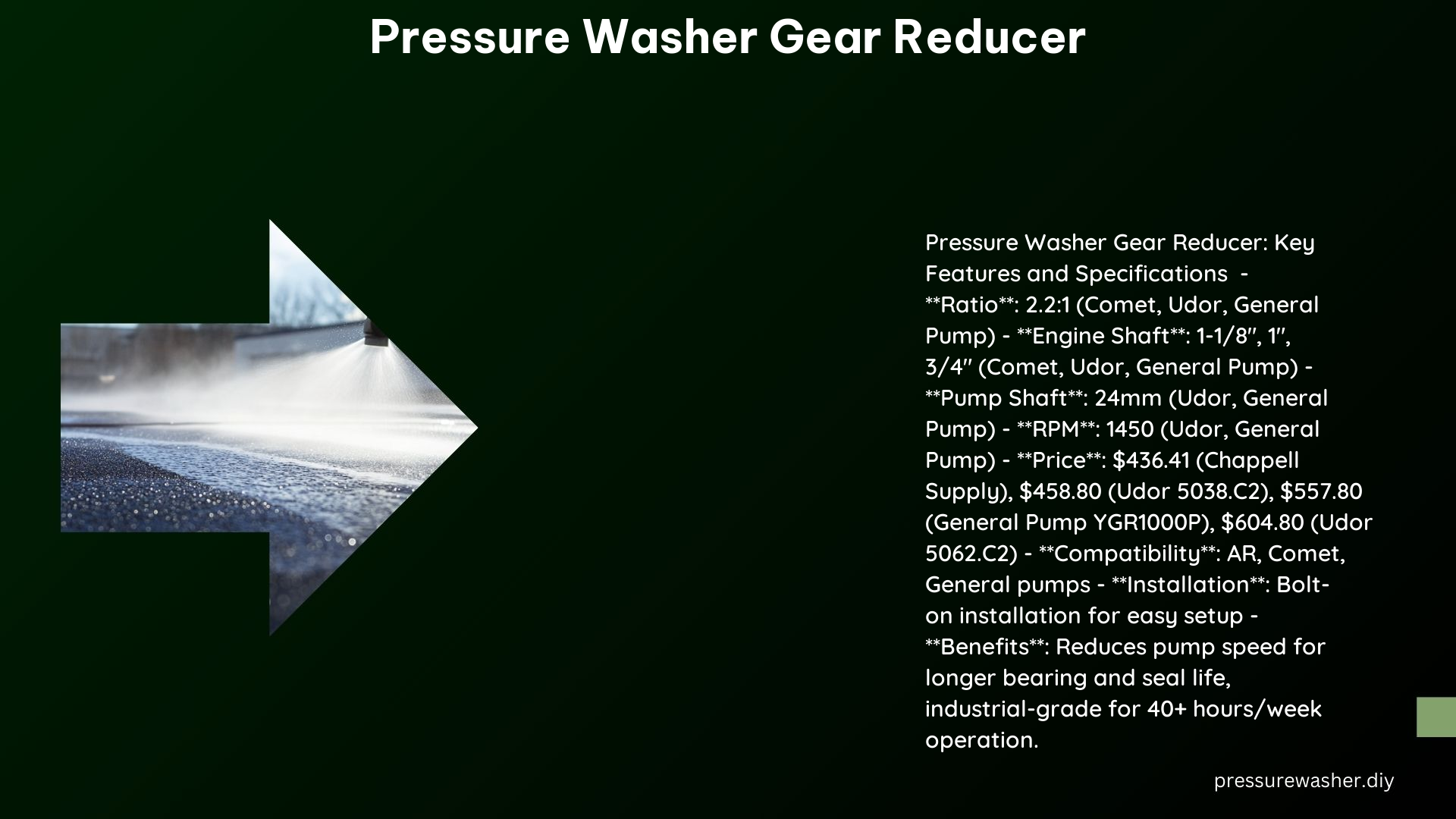A pressure washer gear reducer is a critical component used to slow down the speed of the pump in a pressure washer system, helping to prolong the life of the pump bearings and seals by reducing heat transfer and wear. This comprehensive guide delves into the intricacies of pressure washer gear reducers, covering their typical horsepower range, proper installation, benefits over belt drives, and detailed technical specifications.
What is a Pressure Washer Gear Reducer?
A pressure washer gear reducer is a mechanical device that is installed between the engine and the pump in a pressure washer system. Its primary function is to reduce the rotational speed of the pump, typically by a ratio of 2.2:1 or higher, while maintaining the necessary torque to drive the pump effectively. This speed reduction helps to extend the lifespan of the pump’s bearings and seals by minimizing the heat and stress generated during operation.
Gear reducers are designed to be compact, durable, and highly efficient, providing a direct power transfer from the engine to the pump. They are an essential component in pressure washer systems, ensuring smooth and reliable operation while protecting the sensitive pump components.
Typical Horsepower Range for a Pressure Washer Gear Reducer

The typical horsepower range for a pressure washer gear reducer is between 13 and 24 horsepower. This range is determined by the size and power output of the pressure washer’s engine, as well as the specific requirements of the pump being driven.
Smaller pressure washers with engines in the 13-15 horsepower range may use gear reducers with a 2.2:1 or 2.5:1 reduction ratio, while larger models with engines up to 24 horsepower may require gear reducers with a 3:1 or even 4:1 ratio to ensure optimal pump performance and longevity.
It is essential to select a gear reducer that is properly sized and matched to the pressure washer’s engine and pump specifications to ensure efficient and reliable operation.
How to Properly Install a Gear Reducer for a Pressure Washer
Properly installing a gear reducer for a pressure washer is a critical step to ensure the system functions as intended. Here’s a step-by-step guide:
-
Choose the Correct Gear Reducer: Select a gear reducer that is compatible with your pressure washer’s pump and engine specifications. This includes matching the shaft sizes, reduction ratio, and mounting configuration.
-
Mount the Gear Reducer: Position the gear reducer between the pump and the engine, ensuring proper alignment and secure fastening. This may involve using mounting brackets or direct bolt-on connections, depending on the specific gear reducer model.
-
Connect the Shafts: Carefully connect the engine shaft to the input of the gear reducer and the pump shaft to the output of the gear reducer. Ensure proper alignment and use any necessary coupling devices or adapters.
-
Check and Adjust: Thoroughly inspect the gear reducer installation, checking for any signs of misalignment, binding, or excessive vibration. Make any necessary adjustments to the mounting or shaft connections to ensure smooth and efficient operation.
-
Lubricate the Gear Reducer: Follow the manufacturer’s recommendations for the type and quantity of lubricant required for the gear reducer. Proper lubrication is essential for long-term performance and durability.
-
Verify Operation: Start the pressure washer and observe the gear reducer’s operation. Check for any unusual noises, excessive heat, or signs of wear. Make any final adjustments as needed to optimize the system’s performance.
Proper installation of the gear reducer is crucial for ensuring the longevity and reliable performance of your pressure washer system.
Benefits of Using a Gear Reducer Versus a Belt Drive in a Pressure Washer
While both gear reducers and belt drives can be used to transfer power from the engine to the pump in a pressure washer system, there are several key advantages to using a gear reducer:
-
Increased Efficiency: Gear reducers provide a more direct and efficient power transfer, with minimal energy losses due to friction or slippage. This results in a higher overall system efficiency, translating to better performance and fuel economy.
-
Improved Durability: Gear reducers are inherently more durable and less prone to wear and tear compared to belt drives. They are less susceptible to environmental factors, such as temperature, moisture, and debris, which can degrade belt performance over time.
-
Compact Design: Gear reducers are generally more compact and space-efficient than belt drive systems, making them ideal for pressure washers with limited mounting space.
-
Reduced Maintenance: Gear reducers require less maintenance than belt drives, as they do not require periodic belt tensioning or replacement. This can result in lower operating costs and less downtime for the pressure washer.
-
Consistent Power Transmission: Gear reducers provide a consistent and reliable power transmission, ensuring that the pump receives the necessary torque and speed to maintain optimal performance, even under varying load conditions.
These advantages make gear reducers a preferred choice for many pressure washer manufacturers and users who prioritize efficiency, durability, and ease of maintenance.
Technical Specifications of Pressure Washer Gear Reducers
To provide a more detailed understanding of pressure washer gear reducers, here are some technical specifications for a few popular models:
| Model | Ratio | Type | Engine Shaft | Pump Shaft | RPM | Price |
|---|---|---|---|---|---|---|
| 5062.C2 | 2.2:1 | Udor | 3/4″ | 24mm | 1450 | $604.80 |
| 5038.C2 | 2.2:1 | Udor | 1″ | 24mm | 1450 | $458.80 |
| YGR1000P | 2.2:1 | General Pump | 1″ | 24mm | 1450 | $557.80 |
These gear reducers feature a 2.2:1 reduction ratio, which is a common specification for pressure washers in the 13-24 horsepower range. The engine shaft sizes vary from 3/4″ to 1″, while the pump shaft is standardized at 24mm (approximately 0.94 inches) to accommodate a wide range of pump models.
The RPM of these gear reducers is typically around 1450, which is a suitable speed for most pressure washer pumps to operate efficiently and reliably. The price range for these gear reducers can vary depending on the manufacturer, features, and overall quality.
It’s important to note that the specific technical specifications may differ depending on the pressure washer model, engine size, and pump requirements. Always consult the manufacturer’s recommendations or work with a qualified technician to ensure you select the appropriate gear reducer for your pressure washer system.
Conclusion
Pressure washer gear reducers are a critical component that play a vital role in the efficient and reliable operation of pressure washer systems. By understanding the typical horsepower range, proper installation procedures, and the benefits of gear reducers over belt drives, you can make informed decisions when selecting and using these essential components.
Remember to always refer to the manufacturer’s recommendations and specifications when choosing and installing a gear reducer for your pressure washer to ensure optimal performance and longevity.
References:
- Ultimate Washer. (n.d.). Pressure Washer Gear Boxes. Retrieved from https://www.ultimatewasher.com/pressure-washer-gear-boxes.htm
- Pressure Washer Parts. (n.d.). General Pump Pressure Pump Gear Reducers. Retrieved from https://www.pressure-washer-parts.com/gear-reducers
- Chappell Supply. (n.d.). GEAR REDUCER – 3/4″ Shaft. Retrieved from https://www.chappellsupply.com/pc_product_detail.asp?key=7116298EB85247CAB24F843990CAA2AD
- Power Wash Store. (n.d.). PA GEAR REDUCTION – 1″ 11-18hp. Retrieved from https://www.powerwashstore.com/P/920/GeneralPumpGearDrive1-,No3632
- PowerWash.com. (n.d.). Gear Boxes. Retrieved from https://powerwash.com/product-category/pressure-washer-parts/pump-and-parts/gear-boxes-reducers/
